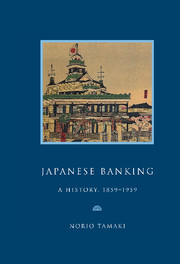Book contents
- Frontmatter
- Contents
- Preface
- Genealogy of leading Japanese banks, 1859–1959
- List of abbreviations
- Map
- Part I A bankrupt Shogunate, 1859–1868
- Part II The Meiji Restoration: monetary confusion and banking experiments, 1868–1881
- Historical background
- 5 The first banking experiment, 1868–1872
- 6 The national bank system: the American influence, 1870–1881
- 7 The origins of ordinary banking: another bank mania, 1875–1881
- 8 The search for stability: the last bank controversy, 1879–1881
- Part III Matsukata, the wizard of Japanese banking, 1881–1897; the Yokohama Specie Bank (1880) and the Bank of Japan (1882)
- Part IV The Japanese on the London money market, 1897–1911
- Part V War, the Japanese boom years, 1911–1919
- Part VI Crisis and the road to war, 1919–1937
- Part VII Complete commitment, struggle and defeat, 1937–1945
- Part VIII American ‘democratisation’ and the search for growth, 1945–1959
- An extraordinary century, 1859–1959
- Appendices
- Notes
- Bibliography
- Index
5 - The first banking experiment, 1868–1872
Published online by Cambridge University Press: 03 February 2010
- Frontmatter
- Contents
- Preface
- Genealogy of leading Japanese banks, 1859–1959
- List of abbreviations
- Map
- Part I A bankrupt Shogunate, 1859–1868
- Part II The Meiji Restoration: monetary confusion and banking experiments, 1868–1881
- Historical background
- 5 The first banking experiment, 1868–1872
- 6 The national bank system: the American influence, 1870–1881
- 7 The origins of ordinary banking: another bank mania, 1875–1881
- 8 The search for stability: the last bank controversy, 1879–1881
- Part III Matsukata, the wizard of Japanese banking, 1881–1897; the Yokohama Specie Bank (1880) and the Bank of Japan (1882)
- Part IV The Japanese on the London money market, 1897–1911
- Part V War, the Japanese boom years, 1911–1919
- Part VI Crisis and the road to war, 1919–1937
- Part VII Complete commitment, struggle and defeat, 1937–1945
- Part VIII American ‘democratisation’ and the search for growth, 1945–1959
- An extraordinary century, 1859–1959
- Appendices
- Notes
- Bibliography
- Index
Summary
Ryo to yen, 1868–1871
On 3 January 1868, a coup, plotted by a group of radical court nobility and supported by the powerful domains of both Satsuma and Choshu, ignited a fuse which led eventually to the overthrow of the Tokugawa Shogunate regime. On 27 January, the bakufu troops, greatly outnumbering the Satsuma and Choshu forces, were easily defeated on the outskirts of Kyoto. Yoshinobu Tokugawa, the last Shogun, dashed to his battleship and fled to Edo. The victory was a tremendous boost to the allied forces of Satsuma and Choshu, who became known as the ‘imperial troops’ and who marched briskly eastwards, reaching Edo in two months. The bakufu surrendered Edo castle on 3 May. On 22 May 1868, Sir Harry Parkes, the British Minister, presented his credentials to the Emperor in Kyoto; thus, the British acknowledged the legitimacy of the new government, with the Emperor at its head. Although the civil war still continued fiercely in northwestern Japan, the Meiji government was firmly established by the end of 1868. Financially, however, the government faced formidable problems.
The coinage system, which dated from the establishment of the Tokugawa Shogunate in 1600, and on which the Japanese people relied, was in a state of chaos. Constant debasement during the Shogunate regime had made the system, which had numerous sorts of coins in circulation, fundamentally unreliable. There were eleven types of gold coins, which accounted for 54 per cent of the total coin circulation in 1869, seven varieties of silver coins, 42 per cent of the total, and six sorts of copper coins.
- Type
- Chapter
- Information
- Japanese BankingA History, 1859–1959, pp. 22 - 27Publisher: Cambridge University PressPrint publication year: 1995



